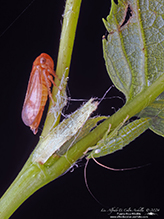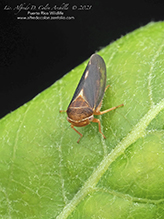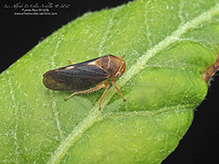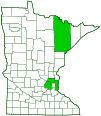leafhopper
(Oncopsis sobria)
Conservation • Description • Habitat • Ecology • Distribution • Taxonomy
|
|
||||||||||||||
Description |
Oncopsis sobria is a small, native, typical leafhopper. It occurs in the United States in the east from Maine to Maryland, west to Minnesota, and south along the Appalachian Mountains to North Carolina. In the west it occurs from Washington to Montana. It also occurs in southern Canada from Nova Scotia west to Ontario, and from British Columbia east to Saskatchewan. Given its broad distribution, it is probably much more common than the relatively few scattered records indicate. Adults and nymphs are found from late May to early August. They feed on plant juices of paper birch, water birch, yellow birch, and sometimes gray birch. Males are 3⁄16″ (4.5 to 5.5 mm) in length, females are 3⁄16″ to ¼″ (4.8 to 5.8 mm) in length. The body is brown to orangish brown without contrasting markings. The crown is very short. The face is longer than wide. The front margin of the exoskeletal plate on the first segment of the thorax (pronotum) is rounded and extends well forward in front of the eyes. It is densely and conspicuously grooved (striate). The striations are irregular, wrinkle-like, and are parallel with the rear margin of the pronotum. The forewings (hemelytra) are relatively short and are broadly rounded at the tip. There are three small, interior (anteapical) cells before the cells at the wingtip. On males, the hemelytra range from dark brown to jet black. The underside of the body (venter) is yellowish brown or orangish brown. There is sometimes pale yellow on the face. The legs are yellowish. Males with black hemelytra have a strong violet sheen. On brown-winged males, the pronotum and the plate between the wing bases (scutellum) are dark brown with dark brownish gray speckling. On females, the body and hemelytra are usually both rusty brown to orange overall. On some females, the hemelytra are blackish, resembling the male. On these females, the head is yellowish, the face is yellow or rusty brown, the pronotum is yellowish, and the scutellum is dark reddish. The venter is bright yellow. |
Size |
Male total length: 3⁄16″ (4.5 to 5.5 mm) Female total length: 3⁄16″ to ¼″ (4.8 to 5.8 mm) |
Similar Species |
Habitat |
Paper birch, water birch, yellow birch, and sometimes on gray birch |
Ecology |
Season |
Late May to early August |
Behavior |
|
Life Cycle |
|
Nymph Food |
Plant juices of birch |
Adult Food |
Plant juices of birch |
Distribution |
||
|
Sources Medler, John T. (1942). The leafhoppers of Minnesota. University of Minnesota. Minnesota Agricultural Experiment Station. Retrieved from the University of Minnesota Digital Conservancy, https://hdl.handle.net/11299/204089. |
|
| 10/1/2024 | ||
Occurrence |
||
|
||
Taxonomy |
|
Order |
Hemiptera (True bugs, Hoppers, Aphids, and Allies) |
Suborder |
Auchenorrhyncha (true hoppers) |
Infraorder |
Cicadomorpha (spittlebugs, cicadas, leafhoppers and treehoppers) |
Superfamily |
Membracoidea (leafhoppers and treehoppers) |
Family |
|
Subfamily |
Eurymelinae |
Tribe |
Macropsini |
Genus |
|
Subgenus |
Oncopsis |
Subordinate Taxa |
|
|
|
Synonyms |
|
Bythoscopus sobrius Oncopsis sobrius |
|
Common Names |
|
This species has no common name. The common name of the family Cicadellidae is typical leafhoppers, and it is applied here for convenience. |
|
Glossary
Hemelytron
The forewing of true bugs (order Hemiptera), thickened at the base and membranous at the tip. Plural: hemelytra.
Pronotum
The exoskeletal plate on the upper side of the first segment of the thorax of an insect.
Scutellum
The exoskeletal plate covering the rearward (posterior) part of the middle segment of the thorax in some insects. In Coleoptera, Hemiptera, and Homoptera, the dorsal, often triangular plate behind the pronotum and between the bases of the front wings. In Diptera, the exoskeletal plate between the abdomen and the thorax.
Striate
Striped or grooved in parallel lines (striae).
Visitor Photos |
||
Share your photo of this insect. |
||
This button not working for you? |
||
Alfredo Colon |
||
 |
 |
|
 |
||
MinnesotaSeasons.com Photos |
||
|
||
|
||

Slideshows |
|

Visitor Videos |
||
Share your video of this insect. |
||
This button not working for you? |
||
|
Other Videos |
||
|

Created: 10/27/2023 Last Updated: © MinnesotaSeasons.com. All rights reserved. |



